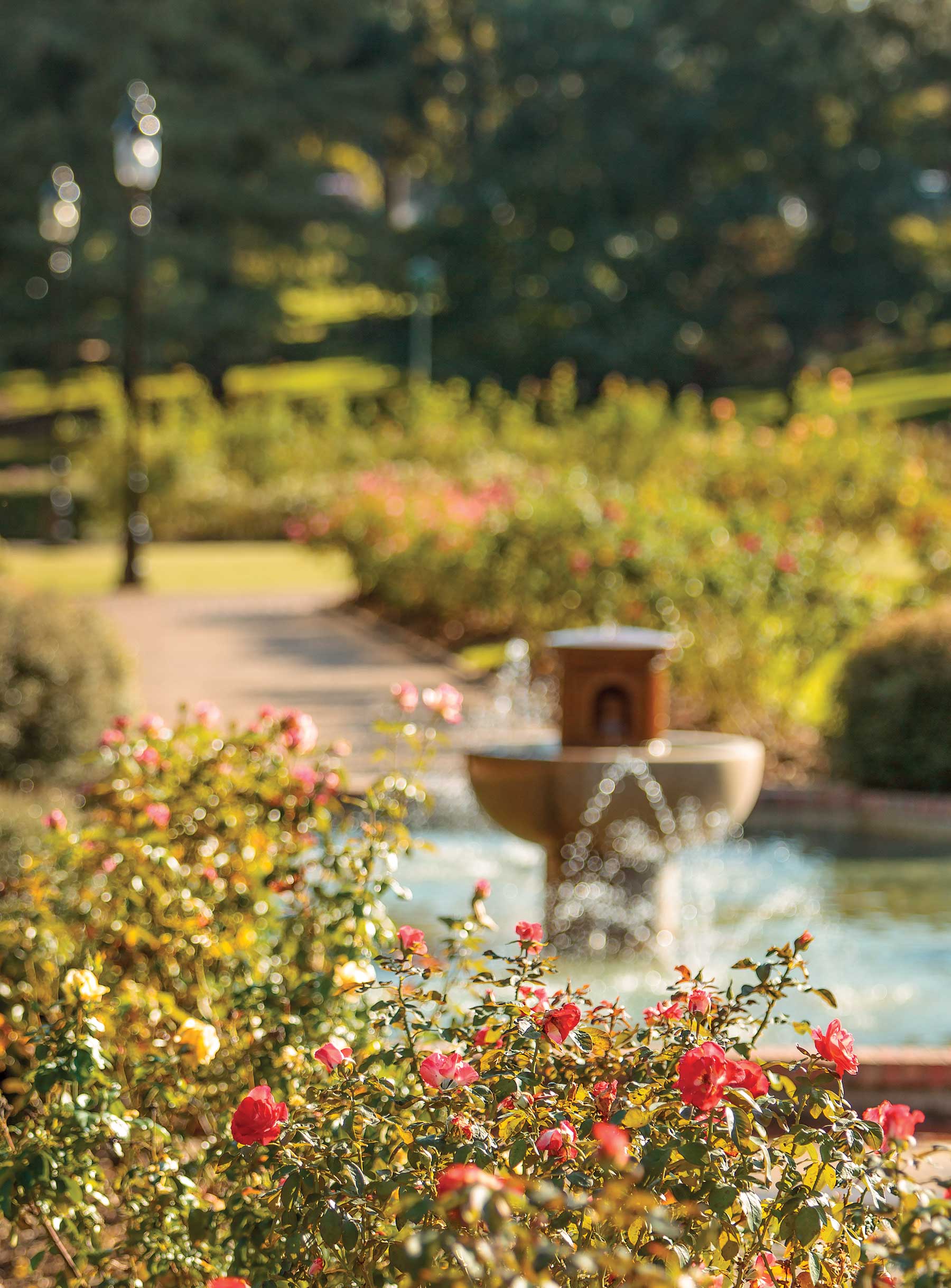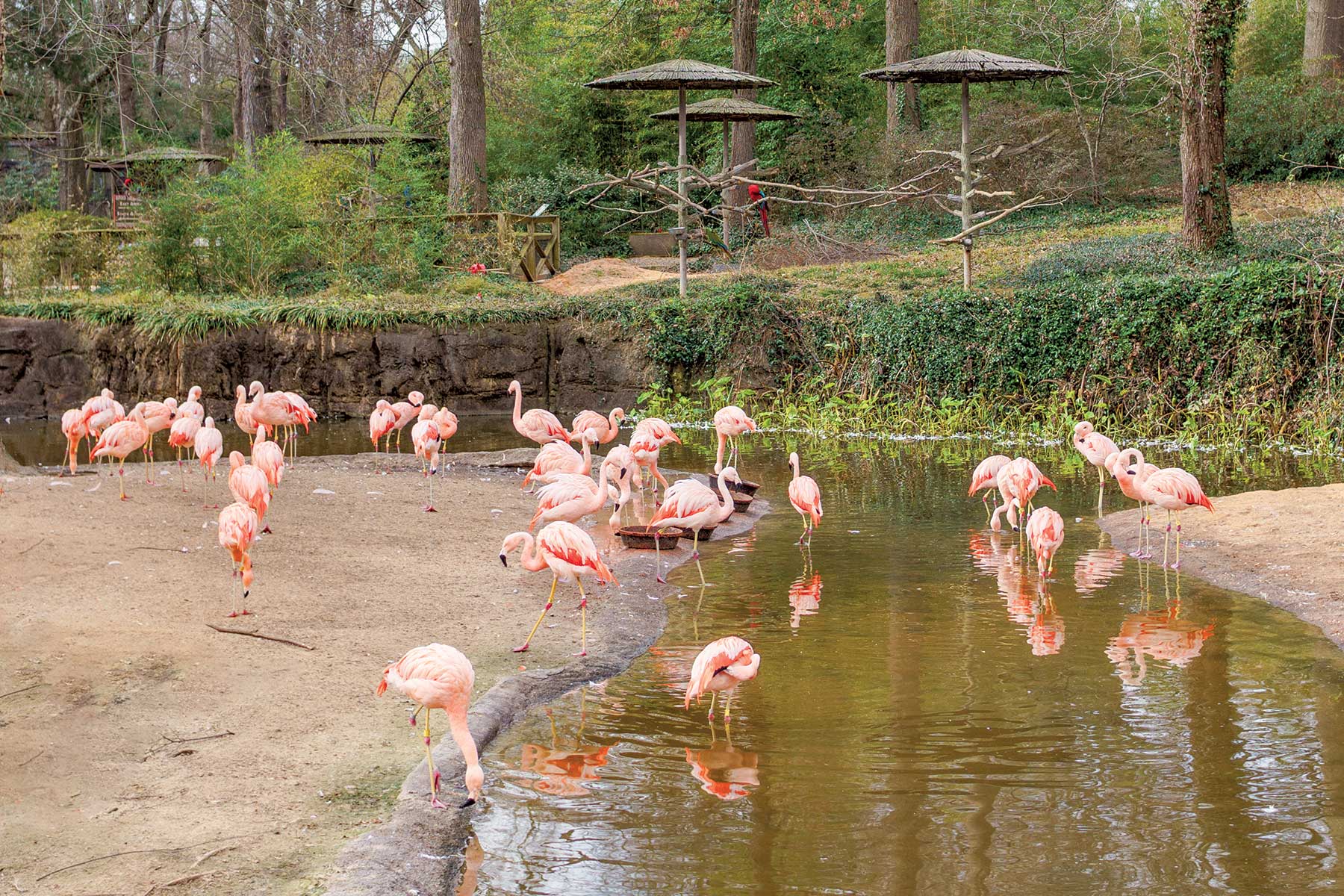
Kuhlken Photography
Smelling like a rose
Tyler is full of natural and cultural attractions
People in Tyler take their roses seriously. The city proclaims itself the “Rose Capital of America,” and its Rose Festival, held each fall, brings people together to celebrate all things rose.
Tyler is one of the nation’s rose-growing centers; at one time, half of all rose bushes sold in the U.S. came from the area. The city has many other home-grown charms as well.
A leading city of East Texas, Tyler boasts an art museum, a zoo, three colleges, major hospitals, a symphony orchestra and a thriving downtown. And if Texas is where the South meets the West, Tyler’s azaleas, magnolias and pines make it feel firmly rooted in the South.

Earl Nottingham | TPWD
The Tyler Municipal Rose Garden is one of the world’s largest.
My girlfriend Heather and I begin our trip at Tyler State Park. Camping seems like a safe bet during the pandemic, and I love the park’s trees and historic Civilian Conservation Corps buildings.
A spring-fed lake serves as the centerpiece of the park. Visitors come from around the state to camp, swim, fish, hike and mountain bike.
“We get a lot of folks escaping the big cities,” says park ranger Boyd Sanders. “When you pull into the park, you get the feeling of leaving civilization. You’re surrounded by pine trees.”
Local historian Vicki Betts has agreed to meet us at the CCC-built bathhouse to fill us in on some park history. Tyler State Park was at the center of the battle to open parks to African Americans in the 1950s. Lawsuits and protests by Black residents of Tyler led to changes in state policy allowing “separate but equal” access at state parks. In response, Tyler created a separate area for Black people across the lake from the main part of the park.
“It was separate but not equal,” Betts says. “They could come in and fish and swim on the other side. There’s a letter from a Black leader in Tyler saying, ‘We shouldn’t be settling for this muddy end of the lake.’”
The Civil Rights Act of 1964 finally cleared the way for full access.
After talking with Betts, we set up our tent and settled in for a night of sitting around the campfire, looking at the stars and contemplating our state’s complicated history.

The next morning brings rain, and we decide to start the day indoors. We head to the Tyler Museum of Art, which features work from notable Texas artists.
“We have 800 pieces in our permanent collection, and have lots and lots of folk art,” says Pattie Copeland, working the visitor services desk.
In one gallery we see everything from Porfirio Salinas’ bluebonnets to Bill Montgomery’s semi-surreal landscapes. I’m particularly pleased to see the current exhibition, “Ode to East Texas” (ending mid-March), containing works by Lee Jamison, who is one of the artists selected to paint state parks for the state park centennial coming in 2023.

Earl Nottingham | TPWD
Camp Ford housed Civil War Prisoners
We’re making it a museum morning, and our next stop is the Tyler Rose Museum, which showcases the history of the rose industry and, more flamboyantly, the history of the Rose Festival and its Rose Queens.
In 1900, the Tyler area was a major producer of fruit, particularly peaches. When peach blight wiped out most of the trees, farmers began planting roses instead, and the soil and climate proved ideally suited to growing them. The industry blossomed into a multimillion-dollar business.
In 1933, civic leaders were inspired to create the Rose Festival to celebrate Tyler’s growing fame as a city of flowers. The festival has grown to include events such as the Queen’s Coronation, the Queen’s Tea and the Rose Parade. It’s become a real source of civic pride and a place where Tyler residents have come together to celebrate for generations. Tyler’s young women dream of becoming duchesses, ladies-in-waiting or even queen, while young men progress from being royal attendants to royal escorts.
“There’s a funny phenomenon that happens when you’re queen of the Rose Festival,” says former queen Louise Spence Griffeth in the museum video. “It’s almost like you have fairy dust sprinkled on you. It’s very magical.”
Fairy dust was definitely involved in the making of the festival’s glamorous costumes and gowns. The museum’s Portraits of Inspiration collection from 2019 contains elaborate festival costumes inspired by figures such as Amelia Earhart, Barbie and Marie Antoinette (sporting a castle headdress). The head-spinning dresses are bedazzled with enough sequins, jewels, rhinestones and feathers to make a queen blush.
Adjacent to the museum, the Tyler Municipal Rose Garden is one the world’s largest rose gardens, showcasing 32,000 rose bushes consisting of more than 500 varieties in its 14 acres. From the balcony, we gaze out on what almost looks like a royal garden, with winding walkways and gurgling fountains. We make note of rose varieties with names like Rio Samba, Sun Flare and Yabba Dabba Do. It’s still winter, but we see several camillias showing their colors.
Downtown Tyler bustles with workers, students and other residents. Tyler benefited from an influx of wealth and business from the discovery of the East Texas oilfield in the 1930s, and while oil gushed from wells in places like nearby Kilgore, Tyler handled the money side of the business as numerous oil companies set up shop downtown.
We pop into the visitor center operated by Visit Tyler.
“We’re mostly known for the roses,” says visitor center worker Abby Floyd. “Tyler is getting bigger, but we still have a small-town feeling.”
Floyd grew up in Tyler and attends Tyler Junior College. In high school, she was selected to be an Azalea Belle, where she dressed in antebellum hoop skirts and served as an official greeter for the Azalea Trail.
Serving as a complement to fall’s Rose Festival, the Azalea and Spring Flower Trail celebrates the arrival of spring in Tyler. The 10-mile driving trail features residential gardens and historic homes bursting with azaleas, tulips, wisteria, dogwood and more. This year’s festival runs from March 19 to April 4.
Just off the downtown square, the Smith County Historical Society strives to collect and preserve the area’s history. The society’s home, a 1904 Carnegie Library building, is itself a historical treasure. I have an appointment to meet office manager Carla Lacy there. Along with Lacy, a larger-than-life Lady Justice statue from the top of the old courthouse greets us as we walk in the door.
The exhibits trace Tyler’s history as it progressed through cotton, roses and oil. I loved watching Earl Campbell play football, and I’ve been keeping my eye out for anything referring to the Tyler Rose. I find what I’m looking for in a display featuring Ann Campbell, Earl’s mom, in a section devoted to notable Tyler women.
The society also maintains a vast archive of photos, school yearbooks, family histories and more. Lacy shows me multiple boxes of recently donated material that await sorting and filing.
“Because of COVID, people are cleaning out their houses,” she says. “We are getting a lot of donations.”
The historical society also manages Camp Ford, a former prisoner-of-war camp run by the Confederate Army. It was the largest such camp west of the Mississippi River. At its peak, more than 5,000 prisoners were held there.
As we approach the camp, on the edge of town, it’s hard to miss the palisade fencing that resembles a frontier fort. Inside, informational exhibits explain how prisoners built makeshift cabins, tried to alleviate their boredom and even occasionally escaped. Conditions grew dire as inmates flooded in. The final prisoners left in May 1865. Today, we have a pleasant walk through the grounds, trying to imagine what life must have been like back then.
With the day winding down, our attention turns to food. We decide to get takeout from Stanley’s Famous Pit Bar-B-Q and return to our campsite to eat. Stanley’s, renowned as one of the top barbecue spots in the state, goes all in on some East Texas specialties, and we’re crushed when we find out they are out of pork ribs. We go for a three-meat platter of brisket, pulled pork and smoked turkey. The turkey proves to be a surprise standout — peppery and moist and mouth-wateringly good.
The next day, we arrive at the Caldwell Zoo in time for our 10 a.m. entry slot. The zoo began in 1938 as a menagerie of squirrels and parrots in the backyard of the Caldwell family and has grown into an 85-acre zoo containing more than 2,000 animals. The zoo is accredited by the Association of Zoos and Aquariums, meaning it meets high standards of animal care and participates in breeding programs.
As we walk in, we encounter the graceful elegance of the flamingoes next to the high-energy antics of some squirrel monkeys.
A girl traces her finger across the park map, through the various exhibits, until she finds what she wants. “I know how to get to the lions!” she exclaims.
Species come from East Africa, North America and South America. The highlight is the African plains exhibit, where zebras roam, lions lounge and giraffes eat lettuce out of the hands of young zoo visitors. On the opposite side of the exhibit, where the lions live, a clever bit of optical trickery makes it look as if the lions share the same habitat with some tasty zebras. No doubt that little girl at the entrance found her way here.
If you want to find your way to Tyler, just trace your finger along the map to the eastern edge of the state and find the place where the pine trees grow tall and the rose bushes fill the air with civic pride.
COVID-19 MAY AFFECT YOUR TRIP. CHECK FOR CLOSURES, LIMITED HOURS OR NEW PROCEDURES BEFORE VISITING.
Related stories
» Like this story? If you enjoy reading articles like this, subscribe to Texas Parks & Wildlife magazine.




